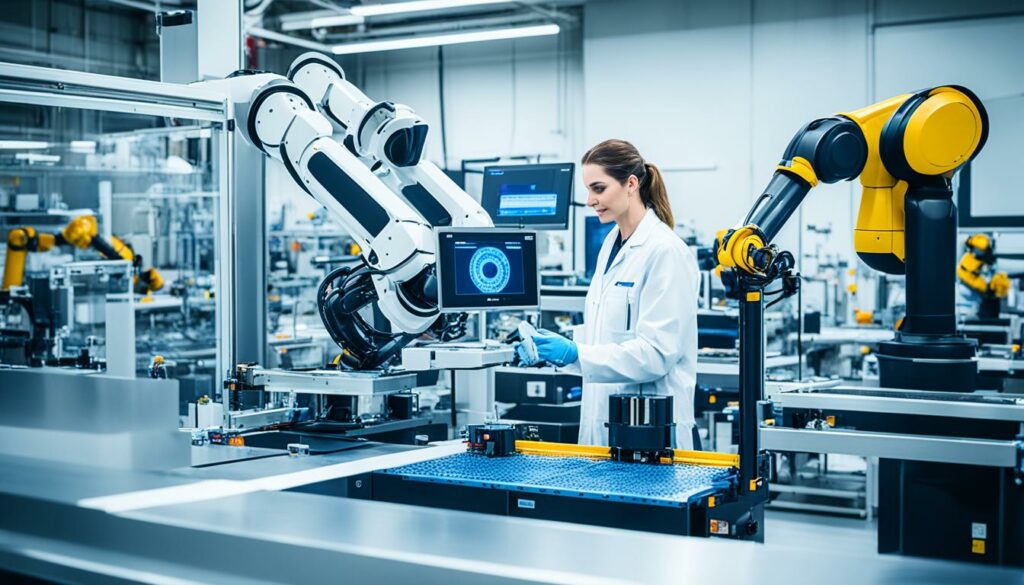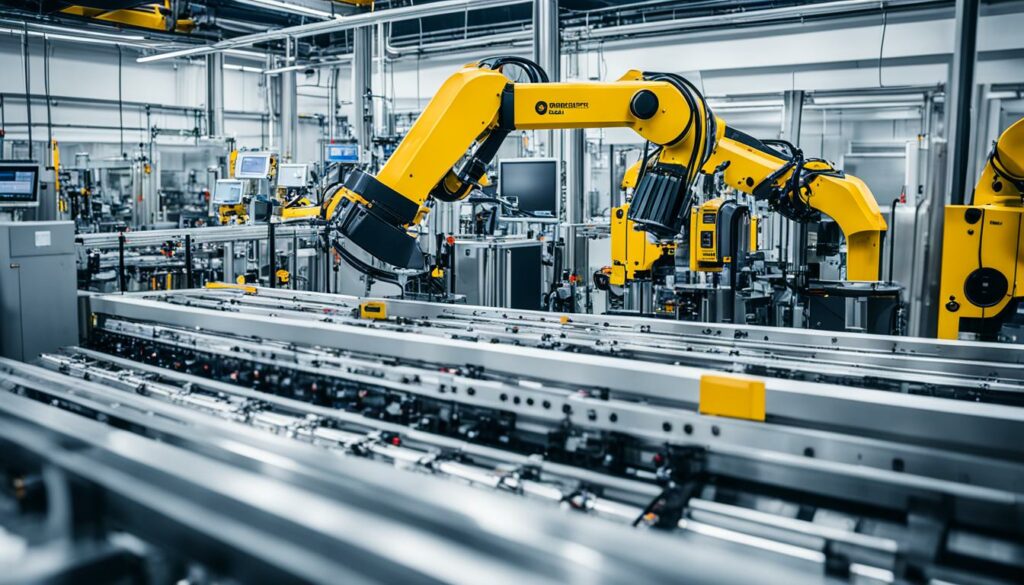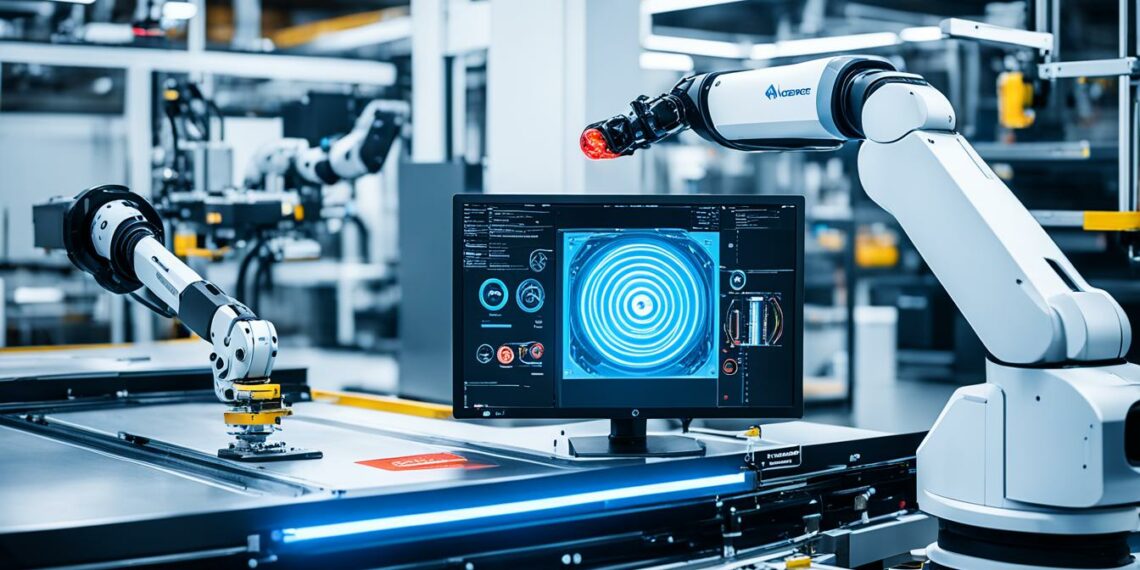Did you know that 64% of manufacturers now use AI every day? This is especially true for quality control, where AI is changing the game. With the AI service market expected to hit $130 billion by 2025, companies are turning to AI for better efficiency and accuracy.
AI is making manufacturing faster and more accurate. It helps find defects quicker, which makes customers happier and builds trust in a brand. Using AI in quality control also cuts costs and makes navigating Industry 4.0 easier. Machine learning and computer vision could improve production by up to 30%.
We’re exploring how AI is changing quality control in manufacturing. It’s making things like predictive maintenance and automated checks better. Learn how these changes lead to better efficiency and quality by checking out AI in manufacturing.
Key Takeaways
- AI in quality control has greatly improved how things work.
- Companies are using AI to find defects and ensure quality better.
- AI helps reduce mistakes in checking products.
- Predictive maintenance is key to avoiding equipment problems.
- Using data in real-time helps make better decisions in manufacturing.
- Good training data is vital for AI to work well in quality control.
- AI’s role in manufacturing can cut waste and boost production.
Understanding the Importance of Quality Control in Manufacturing
Quality control is key to making customers happy and keeping a good brand name. It makes sure products are up to standard and even better than what customers hope for. By being strict with quality checks, companies can cut down on defective products. This helps them keep their good name.
The Role of Quality Control in Customer Satisfaction
Customers want products that work well and don’t break easily. Good quality control makes sure this happens, building trust and loyalty. When companies focus on quality, they make customers happy. This leads to more sales and good reviews, helping them build strong relationships with customers.
Impact of Quality Control on Brand Reputation
Being serious about quality control makes a brand look good. Companies with high quality standards are trusted more by people. If they send out defective products, it can really hurt their sales and how people see them. Keeping up with quality control helps a brand stay strong and be a leader in its field.
Consequences of Poor Quality Control on the Bottom Line
Not having good quality control can really cost a lot. The costs of redoing work, taking back products, and making customers unhappy add up. This can hurt profits. Plus, a brand’s good name can get damaged, leading to losing customers. Companies need to see investing in quality control as a way to do well in the long run.
| Aspect | Impact of Quality Control | Consequences of Poor Quality Control |
|---|---|---|
| Customer Satisfaction | Enhanced trust and repeat purchases | Increased returns and complaints |
| Brand Reputation | Positive public perception and loyalty | Loss of credibility and market share |
| Financial Performance | Improved profitability and cost efficiency | Higher costs associated with defects and customer dissatisfaction |
Challenges in Traditional Quality Control Processes
Traditional quality control processes have many challenges that affect their effectiveness and efficiency. These challenges come from relying on human inspectors. This can lead to human error, slow inspections, and limited resources. It’s important for manufacturers to understand these issues to improve quality management.
Human Error in Manual Inspections
Human error is a big problem in quality control. Inspectors might miss defects because they are tired, distracted, or have personal biases. This leads to inconsistent quality checks. Studies show that manual inspections can miss defects by 60-90%, showing how unreliable human checks can be.
This makes it hard to keep product quality high.
Time-Consuming Inspection Methods
Manual inspections slow down production, especially in fast-paced manufacturing. They take a lot of time, which can slow down the whole process. This slow pace hurts productivity and makes it hard for companies to meet market demands.
Companies often end up paying more because of these inefficiencies in quality control.
Limitations of Human Expertise and Resources
Not all inspectors have the right skills or training to spot defects, especially in complex products. Training a skilled team is expensive, especially when production grows. Limited resources make it hard for companies to keep quality high.
For more information on using technology for better data quality and efficiency, visit AI-driven data visualization.
How AI is Revolutionizing Quality Control
In today’s world, AI is changing how companies check quality. Old ways often have errors and are slow. AI brings new tech to make things better and faster.
Introduction to AI-Powered Quality Control Solutions
AI is becoming more popular, and companies are using it for better quality control. These tools help automate checks, making them faster and more accurate. They use algorithms to quickly spot problems.
Benefits of Implementing AI in Manufacturing
AI brings big benefits to quality control in manufacturing. The main advantages are:
- It finds defects more accurately, cutting down on manual checks.
- Automation makes things more efficient, letting engineers focus on tough problems.
- It watches production in real-time, making quick changes when needed.
- It cuts down on quality costs and makes customers happier, seen in many industries.
Data-Driven Decision Making with AI
AI helps make decisions by analyzing data. It looks for patterns and oddities, keeping quality up. This makes things run smoother and helps stop problems early.
AI also helps make production better. It makes sure products meet standards and helps keep a good brand image.
| Industry | Key Benefit of AI | Impact on Quality Control |
|---|---|---|
| Automotive | 30% reduction in quality costs | Improved customer satisfaction |
| Medical Devices | Enhanced compliance | Improved safety and quality |
| Pharma and Life Sciences | Expedited drug development | Reduced approval times |
| Food and Beverages | Real-time monitoring | Brand reputation safeguarding |
AI in Quality Control
AI technologies make quality control better by ensuring products are top-notch. Companies use automated visual inspection to overcome old methods’ limits. These systems use computer vision to spot defects fast, raising standards in many fields.
Automated Visual Inspection Techniques
Automated visual inspection uses smart algorithms to check products quickly. It beats human inspectors in many ways. The main benefits are:
- It finds flaws like scratches and misalignments well.
- It works faster than checking by hand.
- It cuts down on mistakes due to tiredness or missing things.
Role of Computer Vision in Defect Detection
Computer vision is key to spotting defects better. It uses machine learning and deep learning to tell good products from bad ones. For example, AI systems can greatly boost inspection accuracy in:
- Automotive manufacturing, making sure parts are up to standard.
- Electronics production, where precise circuit boards are crucial.
- Pharmaceutical manufacturing, affecting safety and following rules.
Use Cases in Various Manufacturing Sectors
AI-driven quality control works well in many manufacturing areas:
| Sector | Application | Benefits |
|---|---|---|
| Automotive | Inspection of body panels | Improved accuracy, reduced waste |
| Electronics | Component inspection | Higher efficiency, better quality assurance |
| Pharmaceutical | Drug quality checks | Enhanced compliance monitoring, waste reduction |
By adding automated visual inspection to their processes, companies can get more efficient and keep product quality steady. 
Predictive Maintenance through AI
In recent years, predictive maintenance has become key in manufacturing, thanks to AI. This method uses sensor data analysis to watch how equipment works. AI tools help predict when machines might break down, cutting down on sudden failures.
Analyzing Sensor Data for Equipment Performance
For predictive maintenance to work well, we need constant data from the past and now. Sensor data analysis with AI spots small drops in machine efficiency early. This means we can fix things before they get worse, making things run better and more reliably.
Preventing Quality Issues Before They Occur
AI in predictive maintenance helps avoid quality problems by keeping equipment running right. It predicts when machines might fail, so we can fix them before they stop working. This way, we avoid making bad products and save money by not having to replace broken equipment too soon.
Benefits of Proactive Maintenance
Using predictive maintenance has many benefits, including:
- Less downtime by knowing when equipment might fail, so we can fix it when it’s not busy.
- More safety by spotting dangers before they happen, making things safer.
- Saving money by fixing problems early, avoiding big repair bills and lost production.
- Working better by always checking on equipment, helping us plan maintenance and use resources wisely.
- Improving production by finding ways to work better, leading to ongoing improvements.
Utilizing Statistical Process Control with AI
Artificial Intelligence boosts how well manufacturers keep up quality standards. It helps by monitoring data in real-time. This means companies can quickly fix any issues with production. This makes things more efficient and helps keep quality high.
Real-time Data Monitoring for Quality Assurance
Real-time data monitoring is key for keeping quality up in manufacturing. AI helps by looking at processes and spotting quality problems right away. This fast action cuts down on big defects. With statistical process control, companies can quickly adapt to changes, making things more stable.

Identifying Patterns and Trends with AI Algorithms
AI is great at finding patterns and trends in big data that we might miss. This lets manufacturers check many process details at once. It gives deeper insights into how efficient production is. Adding AI to statistical process control helps with predicting maintenance and using resources better, making quality management better.
For more on how automated systems boost campaign success, check this out. It’s key for staying competitive in the market.
Integrating Machine Learning in Manufacturing Quality Assessment
Machine learning has changed how manufacturers check for defects. It makes finding quality issues better and makes processes smoother. By using past production data, machines learn to spot patterns and get more accurate over time.
How ML Innovations Enhance Defect Detection
Machine learning brings new ways to spot defects with high accuracy. AI can check image quality and find defects up to 90% better than humans. This means quicker and more precise fixes during production.
Training AI Models on Production Data
Using production data to train AI models is key. These models learn to spot defects and get better at predicting them. This leads to fewer mistakes and more reliable results, making operations more efficient.
Continuous Improvement through Machine Learning
Machine learning helps with continuous improvement by giving insights. AI watches production in real-time, spotting issues and trends. This helps manufacturers improve their quality control. It creates a culture of constant betterment, leading to better products and operations.
| Aspect | Traditional Methods | Machine Learning Innovations |
|---|---|---|
| Defect Detection Rate | Up to 50% | Up to 90% |
| Response Time to Anomalies | Manual Review | Real-time Monitoring |
| Data Analysis | Static Reports | Dynamic Insights |
| Scalability | Limited | Highly Scalable |
Challenges and Considerations for AI Integration
Adding AI to quality control in manufacturing comes with big challenges. Companies face issues like training data quality, infrastructure costs, and keeping data safe. These are key to making AI work well.
Importance of High-quality Training Data
AI’s success depends a lot on the quality of its training data. Only 33% of quality management pros are ready to use new AI, due to data concerns. Good data is vital for AI models to learn right, with millions of complex parameters. Bad or biased data can make AI fail, leading to poor quality checks.
Assessing Infrastructure and Integration Costs
Costs for infrastructure are a big part of the challenge. Big companies like Siemens and Rockwell Automation are careful with AI, while smaller ones like Intellect and ComplianceQuest move fast. Companies need to plan their budget for AI tools, including systems, upgrades, and software licenses. Full AI-based QMS deployments might wait until early 2025, making planning tricky.
Data Security and Privacy Concerns
Data security is a big worry when adding AI to manufacturing. Companies deal with lots of sensitive data, so strong security is a must. There are ethical and legal issues, like AI biases, which can lead to big compliance problems. To keep AI safe and reliable, companies use methods like adversarial AI and mutation testing. It’s important to balance AI with human insight for good quality checks.
| Consideration | Details |
|---|---|
| Training Data Quality | Essential for accurate AI model performance; affected by the existing data biases. |
| Infrastructure Costs | Includes acquiring systems, updates, and software licenses; larger vendors adopt gradually. |
| Data Security Concerns | Crucial for protecting sensitive information; requires robust protocols to address ethical and legal issues. |
Conclusion
AI is changing how we make things, making companies use new tech better. With AI, businesses can look at lots of data fast and make smart choices. This helps them stay ahead in making quality products, which keeps customers happy and trusting them.
AI makes things run smoother by automating checks and cutting down on mistakes. For example, a drug company using AI can check pills with 99.999% accuracy. This means fewer recalls and happier customers, which helps them grow.
As AI gets better, companies need to see where it can help the most. They should keep an eye on how AI works and train their teams well. By using new tech smartly, companies can lead in quality control. This approach meets what customers want and helps companies grow in a lasting way. For more on using AI for better business insights, check out this resource.
FAQ
What is the role of AI in quality control?
AI helps make manufacturing better by spotting defects fast and accurately. This leads to better products and happier customers.
How can AI improve defect detection?
AI uses smart algorithms and computer vision to quickly check for flaws. It’s more precise than checking by hand.
What are some benefits of implementing AI in manufacturing?
Using AI in quality control cuts down on labor costs and makes inspections more accurate. It also helps make better decisions by using data.
How does machine learning contribute to quality assessment?
Machine learning helps create models that learn from past data. This makes them better at spotting defects and improving efficiency over time.
What challenges do manufacturers face with traditional quality control?
Old methods can be slow and prone to mistakes. They often use too many resources and don’t always ensure quality. This can cost money.
How can AI help with predictive maintenance?
AI looks at sensor data to predict when machines might break down. This lets manufacturers fix things before they cause quality problems.
What is the significance of statistical process control with AI?
AI in statistical process control keeps a close eye on production in real-time. It spots when things don’t match up, keeping quality consistent.
Why is high-quality training data essential for AI integration?
AI needs good data to work right. Bad data can make AI miss defects and not perform well in quality control.
What are the data security considerations for AI in manufacturing?
Keeping AI data safe and private is key. Companies must protect their data from hackers and follow the law.




